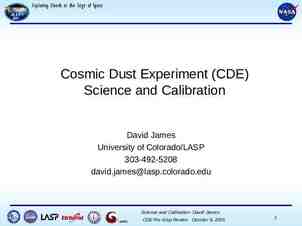Dosimeter for Measuring Lens of Eye Dose Chris Passmore, CHP
15 Slides7.61 MB

Dosimeter for Measuring Lens of Eye Dose Chris Passmore, CHP Mirela Kirr 1 06/30/2 023

Ck Debate Ck factors dependent on phantoms – ORAMED project (Optimization of RAdiation protection for MEDical) for eye lens dosimetry – – – – – Physikalisch-Technische Bundesanstalt (PTB) 2011 – – – – 30 cm x 30 cm x 15 cm slab Water filled Work started in 2012 PTB 2015 – – ORAMED: Optimization of Radiation Protection of Medical Staff, F. Vanhavere, 2011 20 cm high x 20 cm diameter cylinder Water filled Work started in 2008 20 cm high x 20 cm diameter cylinder Water filled OR AM ED PT B Which Ck factors to use? – – ISO 4037-3 has both but cylindrical phantom preferred IEC 62387 adopted cylindrical phantom due to issues noted with slab phantom at large angles 2

International Electrotechnical Commission (IEC) Type Testing IEC TC45/SC45B/WG14 No agreed upon Hp(3) Ck conversion factors internationally until IEC 62387:2012 – Technically no agreed upon method to calculate the lens dose – Ck factors based on Physikalisch-Technische Bundesanstalt (PTB) data 6 – Dose conversion factors defined on slab phantom for Hp(3) in disagreement with ORAMED findings – Slab phantom is widely used and available in many calibration laboratories IEC 62387:2017 used for type testing dosimeters – ORAMED cylindrical phantom and associated Ck factors adopted in this version 3

LANDAUER VISION Dosimeter for Measuring Lens of Eye Dosimeter designed to assess personnel Lens of Eye dose, Hp(3) due to exposure to ionizing radiation using thermoluminescent dosimetry (TLD) technology. Does not interfere with the field of view Can be worn on front or behind protective equipment TLD detector placed in the holder cavity and ultrasonically welded Laser engraved unique identifier for maintaining chain of custody Mounts on safety glasses, shields, face masks or surgical caps Easy cleaning

Performance Testing Dosimeters analysed using CO2 Laser Heated TLD Readers Hp(3) calculated in accordance with current practices for Approved Dosimetry Services for both irradiated groups and background dosimeters Dose calculation algorithm for lens of eye developed with the reader calibrated to Hp(0.07) and dosimeters irradiated to a delivered dose of Hp(3) Background subtracted out of all dosimeters as per current processing procedures

Type Testing Results (I) Meets IEC 62387:2017 verified by 3rd party Irradiations conducted at Laboratoire National Henri Becquerel (LNHB) Test Results Coefficient of Variation Test performed 18 dose equivalent values using Cs-137 Dose equivalent values between 0.05mSv and 10,000mSv Ten dosimeters irradiated between 0.05mSv (5mrem) and 4mSv (400mrem) Pass for Hp(3) between 0.05mSv and 10,000mSv

Type Testing Results (II) Test Results Linearity Pass for Hp(3) between 0.05mSv (5mrem) and 10000mSv (1000mrad) Energy and Angular Response Pass for Hp(3) all energy range from NS30 (24keV) to Cs 137 (662keV), /- 60

Type Testing Results (III) Fade, Build up, Self Irradiation 6 dosimeters groups used (3 groups irradiated to 0.7mSv using Cs-137 and 3 groups used for background monitoring) Group 1 and 4 read 24 hr after irradiation Group 2 and 5 read after one week Group 3 and 6 read after 3 months Fade less than 10% over 3 months

Inter-comparison Studies (I) Test 1 organized by Personal Radiation Monitoring Group (PRMG) in United Kingdom Five personal Dosimetry Services participated The irradiations of dosimeters occurred on cylindrical water phantom, recommended by the ORAMED project and defined in the ISO 4037-3. The irradiation techniques--RQR6 (80kV, 40keV) Results Two groups of doses 0.69mSv (69mrem) and 10.46mSv (1046mrem) Performance analysed based on HSE testing criteria for extremity dosimeters Passed band A and band B with bias of -24% for low doses and -8% for higher doses Dosimeter performance analysed against the ISO 14146, all results pass

Intercomparison Studies (II) Test organized by EURADOS (Session 2016) Dosimeters from 22 Dosimetry Services around the world Dosimeters were irradiated to a variety of photon and beta sources and X Ray techniques at different angles Landauer’s results demonstrates acceptable performance for use in occupational fields requiring lens of eye monitoring. Additional investigation was performed to optimize the dosimeter design Landauer barely outside the trumpet curve for RQR6, 75 32% of participants showed results outside of Trumpet curve for RQR6, 75 Dose to the Lens of the Eye Webinar

2017 Hp(3) Data from Landauer Repository 5281 workers exceeded 2 rem (20 mSv) in 2017 ICRP 103 lens dose limit of 2 rem (20 mSv) per year averaged over 5 years and currently in effect in Europe 12 786 workers exceeded 5 rem (50 mSv) in 2017 – NRC proposed to reduced lens of eye dose limit from 15 rem (150 mSv) to 5 rem (50 mSv) per year 13 27 workers exceeded 15 rem (150 mSv) in 2017 – 15 27 Hp(3) - rem – 5 - 15 759 2- 5 4495 Current 10CFR20 lens dose limit of 15 rem (150 mSv) 14 0 1000 2000 3000 4000 5000 11

Industry Segments with Hp(3) 2 rem (20 mSv) Health Care, Industrial Radiography, University, Radioisotope, Veterinary, and Other (Transportation, Dental, and Research) are Industry Segments with doses greater than 2 rem (20 mSv) – University 6.04% Radioisotope Veterinary Other 0.23% 0.17% 1.86% Industrial Radiography 9.73% University data might be closely associated with Health Care which would make it 88% of the total. Health Care 81.97% 12

27 Participants 15 rem (150 mSv) by Occupation Occupation Industrial Radiography Pain Management - Rehab Radiology - diagnostic radiology Vascular Surgery Interventional Radiology Cardiologist Clinical Psychologist Obstetrics & Gynecology PET Research Pediatrics and Tuberculosis Psychiatry & Neurology Radioisotope Security Threat Detection Research Speech-Language Pathologist Dental Implants % of the Total 15 rem 14.8% 14.8% 14.8% 14.8% 7.4% 3.7% 3.7% 3.7% 3.7% 3.7% 3.7% 3.7% 3.7% 3.7% Categorized workers into disciplines using series codes and internet search Top 5 Occupations 15 rem (150 mSv) – – – – – Industrial Radiography (4) Pain Management – Rehab (4) Diagnostic Radiology (4) Vascular Surgery (4) Interventional Radiology (2) The remaining contained some interesting occupations – – – – Researcher using 18F-FDG positron emission tomography (PET) scans to determine if tuberculosis treatment is working or drug resistant. Psychiatrist specializing in cancer patients Speech Pathologist using video-assisted fluoroscopy of swallowing (VFSS) Dental implants 13

Conclusions Contradictions in ISO and IEC standards have been resolved. – Ck factors exits now to enable calculation of Hp(3) but ANSI N13.11 has not addressed Hp(3). Landauer could provide an ergonomical dosimeter suitable for measuring lens of eye Landauer data shows 5281 workers exceeded Hp(3) of 2 rem in 2017 – 27 of which exceeded the federal limit of 15 rem for Hp(3) Landauer data shows health care industry leads the way with the number of workers with Hp(3) dose 2 rem. – 82% and could be as high as 88% when considering universities. – This can be even more troubling considering non-uniform fields and complication of dosimeter placement. Health care industry will see significant impact if dose limits are reduced with key medical staff members exceeding lens of eye dose threshold regardless if 2 or 5 rem is adopted. – Credit for PPE and shielding similar to Webster effective dose equivalent calculations may be needed going forward. Health care industry will see significant impact if dose limits are reduced with key medical staff members exceeding limits if additional PPE or engineering controls are not implemented. 67% reduction noticed in the number of people exceeding Hp(3) annual limit as compared to the average that exceed in 2014, 2015, and 2016. Data from 2017 NRC Regulatory Information Conference 14

References 1. Federal Radiation Council, Staff Report No. 1, FRC60b, Background Material for the Development of Radiation Standards, May 13, 1960. 2. Landauer’s Technical Basis for Lens-of-Eye Dose Calculation Method, C. Passmore, September 30, 2011 3. Soares CG, Martin PR. A consistent set of conversion coefficients for personnel and environmental dosimetry. Proceedings of the Panasonic User's Group Meeting, Somerset, PA; 5-9 June 1995. 4. ORAMED: Optimization of Radiation Protection of Medical Staff, F. Vanhavere, 2011 5. Radiat Prot Dosimetry, 2012 Jan;148(2):139-42. doi: 10.1093/rpd/ncr028. Epub 2011 Mar 9. Hp(0.07) photon dosimeters for eye lens dosimetry: calibration on a rod vs. a slab phantom. Behrens R 6. NUREG/CR-1595, Radiological Assessment of Steam Generator Removal and Replacement: Update and Revision Table 2, December 1980 7. IAEA - New Dose Limits for the Lens of the Eye Implications and Implementation, E. Vano, Practical issues for implementing the dose limit to the lens of the eye (medical), October 2012 8. Type Test of the Lens of Eye Dosemeter of Landauer, LNHB 2015/37 15






